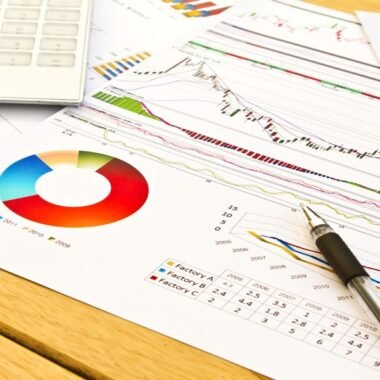Summary: Frequency polygon in statistics are graphical representations of data distributions, formed by connecting class interval midpoints. They offer clear visual insights, enabling comparisons and trend identification. Useful in diverse fields, they simplify complex data, revealing patterns in test scores, economic trends, and more.
Introduction
Ever tried to make sense of a jumble of test scores or fluctuating sales figures? It’s like staring at a puzzle with no picture.” That’s where frequency polygons come in. Imagine you’re tracking the daily temperature in your city. Instead of just a list of numbers, you could plot the mid-range temperatures each month and connect the dots.
Suddenly, you’d see the seasonal trends, the peaks and dips, the whole story. Or picture a teacher comparing the performance of two classes on the same test.
A frequency polygon lets them visually compare the spread of scores, highlighting which class had more students performing at different levels. It’s not just about numbers; it’s about seeing the shape of the data, the story it tells, and that’s the real power of frequency polygon in statistics.
Statistics, in its essence, is about understanding and interpreting data. Raw data, however, can be overwhelming. To make sense of it, we employ various graphical representations, and among them, the frequency polygon stands out for its ability to vividly depict the distribution of continuous data.
Let’s dig deeper into the world of frequency polygons, starting with a practical example.
Key Takeaways
- Frequency polygons provide a continuous, visual representation of data distribution patterns.
- They excel at comparing multiple datasets, revealing differences and similarities effectively.
- These polygons aid in identifying trends over time, crucial for economic and environmental analysis.
- They offer a clear understanding of data shape, including symmetry, skewness, and modality.
- Applications span diverse fields, from educational performance analysis to public health monitoring.
Example: Analysing Student Exam Scores
Imagine a class of 50 students who took a mathematics exam. The scores range from 0 to 100. To understand the distribution of these scores, we first group them into class intervals:
- 0-20
- 20-40
- 40-60
- 60-80
- 80-100
We then count the number of students falling into each interval, obtaining the following frequency distribution:
Now, to visually represent this data using a frequency polygon, we need to find the midpoint of each class interval. These midpoints are called class marks:
- (0+20)/2 = 10
- (20+40)/2 = 30
- (40+60)/2 = 50
- (60+80)/2 = 70
- (80+100)/2 = 90
We plot these class marks on the x-axis and their corresponding frequencies on the y-axis. Connecting these points with straight lines creates the frequency polygon.
Importantly, to complete the polygon, we add two hypothetical class marks at the beginning and end, each with a frequency of zero. In our example, we would add a class mark of -10 with frequency zero and a class mark of 110 with frequency zero.
The resulting frequency polygon in statistics provides a clear picture of the distribution of exam scores. We can easily observe the central tendency, spread, and shape of the data. For example, we might see that the distribution is roughly symmetrical around the 50-60 interval, indicating that most students scored around the middle range.
Detailed Description of Frequency Polygons
A frequency polygon is a graphical representation of a frequency distribution. It is formed by connecting the midpoints of the tops of the rectangles in a histogram with straight lines.
However, unlike a histogram, which uses bars to represent frequencies, a frequency polygon uses lines. This makes it particularly useful for comparing multiple distributions on the same graph.
Key Features and Construction
- Class Marks: The x-axis of a frequency polygon represents the class marks, which are the midpoints of the class intervals. They are calculated by averaging the upper and lower limits of each interval.
- Frequencies: The y-axis represents the frequencies, which are the number of observations falling into each class interval.
- Plotting Points: For each class interval, a point is plotted at the coordinates (class mark, frequency).
- Connecting Points: The plotted points are connected with straight lines to form the polygon.
- Closing the Polygon: To complete the polygon, points with zero frequency are added at the beginning and end of the distribution. These points are located at the midpoints of the hypothetical class intervals preceding and succeeding the actual data.
- Continuous Data: Frequency polygons are best suited for representing continuous data, which can take any value within a given range.
- Shape and Interpretation: The shape of the frequency polygon provides insights into the distribution of the data. It can be symmetrical, skewed, or multimodal.
Advantages of Frequency Polygon
Frequency polygon in statistics provide a streamlined and effective way to visualise and compare data distributions, making them a valuable tool in statistical analysis. Here’s a breakdown of their key strengths:
Ease of Comparison
One of the most significant advantages is their ability to facilitate the comparison of multiple datasets. By overlaying several frequency polygons on the same graph, you can easily identify differences and similarities in their distributions. This is far more visually effective than attempting to compare multiple histograms side-by-side.
Clear Representation of Distribution Shape
The connected lines of a frequency polygon provide a clear and intuitive representation of the data’s distribution. This allows for quick identification of key characteristics such as:
- Central tendency (where the data is concentrated)
- Skewness (whether the distribution is symmetrical or lopsided)
- Kurtosis (the “peakedness” or “flatness” of the distribution)
Versatility with Data Types
While particularly well-suited for continuous data, frequency polygons can also be adapted for use with certain types of discrete data, increasing their versatility.
Space Efficiency
Compared to histograms, which use bars to represent frequencies, frequency polygons use lines. This makes them more space-efficient, especially when presenting data in reports or presentations where space is limited.
Highlighting Trends
When used with time-series data, frequency polygons excel at highlighting trends over time. The continuous line makes it easy to observe changes and patterns in the data.
Application of Frequency Polygon
Frequency polygons offer a powerful visual tool for analysing data distributions. By connecting midpoints of class intervals, they reveal trends and comparisons across datasets. From educational performance to economic trends, disease tracking, and quality control, these graphs provide clear insights into underlying patterns.
Comparative Performance Analysis (Education/Business)
Frequency polygons excel at comparing the performance of different groups or methods. For instance, educators can compare test score distributions of two classes taught with different techniques. Businesses can compare sales figures of two product lines across the same time period. This allows for quick visual identification of which group or method yields better results.
Trend Identification in Time-Series Data (Economics/Environmental Science)
When data is collected over time, frequency polygons can reveal trends and patterns. Economists might use them to track fluctuations in market prices, while environmental scientists could monitor changes in temperature or pollution levels. The continuous line of the polygon makes it easy to spot upward or downward trends, seasonal variations, or cyclical patterns.
Income and Demographic Distribution Analysis (Social Sciences/Economics)
Frequency polygons are valuable for visualizing the distribution of income, age, or other demographic variables within a population. They can reveal income inequality, identify age groups with specific characteristics, or show the spread of social phenomena. This helps researchers and policymakers understand societal patterns and make informed decisions.
Disease Spread and Health Monitoring (Healthcare/Public Health)
In healthcare, frequency polygons can used to track the spread of infectious diseases over time, monitor patient recovery rates, or analyse the effectiveness of medical treatments. Public health officials can use them to identify outbreaks, predict future trends, and assess the impact of interventions.
Quality Control and Process Analysis (Manufacturing/Engineering)
Frequency polygons are useful in manufacturing and engineering for quality control purposes. By plotting the distribution of product dimensions or process parameters, engineers can identify variations and deviations from desired specifications. This helps in detecting and correcting process inefficiencies, minimizing defects, and ensuring product consistency.
In Conclusion
Frequency polygons are powerful tools for visualizing and interpreting the distribution of continuous data. They provide a clear and concise representation of the data, allowing for easy comparison of multiple distributions and identification of trends.
By understanding the construction and interpretation of frequency polygons, we can gain valuable insights into the underlying patterns and characteristics of our data.
Frequently Asked Questions
What Is the Main Difference Between a Frequency Polygon and A Histogram?
A histogram uses bars to represent frequencies, showing actual counts, while a frequency polygon uses lines connecting midpoints, offering a continuous view and aiding comparison between datasets.
Why Do We Add Points with Zero Frequency at The Ends of a Frequency Polygon?
Adding these points completes the polygon and provides a baseline, making it visually clear that the distribution starts and ends at zero, showing the full spread of data.
When Is It More Appropriate to Use A Frequency Polygon Instead Of A Histogram?
Frequency polygons preferred when comparing multiple distributions on the same graph or when visualizing trends in continuous data, as they offer a less cluttered and more fluid representation.




